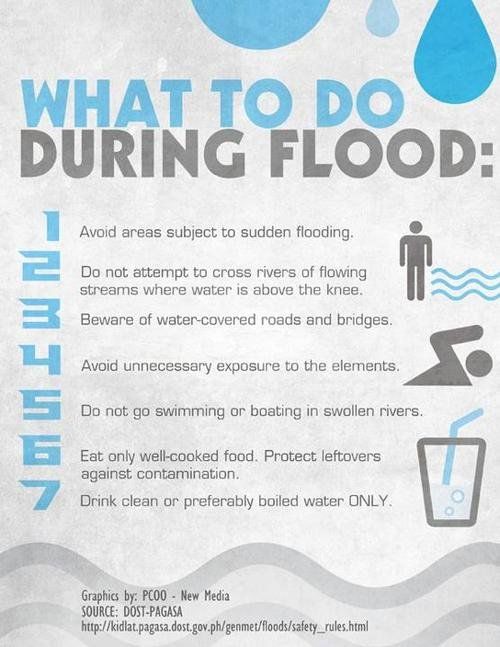Flash Flood Emergency Preparedness: A Survival Guide

Table of Contents
Developing a Comprehensive Flash Flood Preparedness Plan
Identifying Flash Flood Risks in Your Area:
Understanding your local risk is the first step in effective flash flood emergency preparedness. Research your area's flood history; many local governments maintain records of past flood events. Identify areas prone to flooding, such as low-lying regions near rivers, streams, or canyons. Pay attention to geographical features that could exacerbate flooding, like steep slopes or areas with poor drainage.
- Know your evacuation routes: Plan multiple escape routes from your home and neighborhood, considering potential road closures.
- Identify safe high ground locations: Know where you can seek refuge if you're caught in a flash flood. This could be a designated shelter, a higher elevation point, or a sturdy building on higher ground.
- Understand the warning signs: Be alert for rapidly rising water levels, heavy and persistent rainfall, overflowing rivers or streams, and unusual water sounds.
- Subscribe to local weather alerts and emergency notifications: Sign up for your community's emergency alert system and download weather apps that provide real-time flood warnings.
Creating a Family Communication Plan:
Effective communication is critical during a flash flood emergency. Establish primary and secondary contact points for all family members, including out-of-area contacts who can serve as a central point of communication if local networks are down.
- Designate an out-of-area contact person: This person serves as a central hub, receiving updates from family members and relaying information.
- Practice your communication plan regularly: Especially with children, practice how to contact each other and what to do in different scenarios. This familiarizes everyone with the plan and reduces panic during an actual event.
- Use text messages: Text messages often have a higher success rate than phone calls during network congestion.
- Learn alternative communication methods: Familiarize yourself with alternative communication methods like two-way radios or pre-arranged meeting points if cell service is unavailable.
Preparing Your Home for Flash Floods:
Taking proactive steps to protect your home can significantly reduce damage during a flash flood.
- Elevate valuable possessions and appliances: Move important items to higher levels of your home, such as upper floors or elevated shelves.
- Clear gutters and drains: Regularly clean your gutters and downspouts to ensure proper water drainage and prevent blockages.
- Install flood barriers or sandbags: If appropriate for your area and home, consider installing flood barriers or sandbags to help protect your property.
- Trim trees and shrubs: Remove any vegetation that could obstruct waterways or contribute to debris buildup.
- Secure outdoor furniture and equipment: Bring any loose items indoors or securely fasten them to prevent them from being carried away by floodwaters.
- Consider flood insurance: Flood insurance provides financial protection in case of damage from flash floods.
- Know how to turn off utilities safely: Familiarize yourself with the location and operation of your main water, gas, and electricity shut-off valves.
Assembling Your Flash Flood Emergency Kit
A well-stocked emergency kit is essential for surviving a flash flood.
Essential Supplies:
Your kit should contain enough supplies to sustain you and your family for several days.
- Water: At least one gallon per person per day for several days.
- Non-perishable food: Easy-to-prepare items with a long shelf life (canned goods, energy bars, etc.).
- First-aid kit: Include necessary medications, bandages, antiseptic wipes, pain relievers, and any other relevant medical supplies.
- Flashlight, batteries, and a hand-crank radio: Essential for communication and illumination during power outages.
- Blankets or sleeping bags: For warmth and protection from the elements.
- Important documents: Pack copies of important documents (ID, insurance, etc.) in waterproof containers.
- Extra clothing and shoes: Pack enough clothing for several days, including waterproof outerwear.
Important Considerations:
- Special needs: Consider the specific needs of infants, elderly family members, or pets. Include any necessary medications or supplies.
- Cash: Pack cash for emergencies, as ATMs and credit card systems may be unavailable.
- Maps: Include maps of your area and evacuation routes.
- Keep your kit in an easily accessible location: Store your kit in a designated spot, easy to grab in an emergency.
- Regularly check expiration dates: Check the expiration dates on food and water supplies and replace items as needed.
- Practice using your emergency radio: Familiarize yourself with its operation to ensure you can use it effectively during an emergency.
Actions to Take During and After a Flash Flood
Knowing what to do during and after a flash flood is critical for your safety.
During a Flash Flood:
- Evacuate immediately if instructed: Follow the instructions of local authorities and evacuate if instructed to do so.
- Move to higher ground: Avoid floodwaters entirely; they are often contaminated and extremely dangerous.
- Turn off utilities: Turn off gas, electricity, and water if instructed by authorities or if your home is threatened by rising waters.
- Never drive through floodwaters: Floodwaters can be deeper and faster moving than they appear; even a few inches of water can sweep a vehicle away.
- Avoid low-lying areas: Stay away from areas prone to flooding.
- Be aware of rising water levels: Continuously monitor the water level and seek higher ground if it rises rapidly.
- Stay informed: Keep updated via weather reports and emergency broadcasts.
After a Flash Flood:
- Avoid floodwaters: Floodwaters may be contaminated with sewage and other harmful substances.
- Check for damage: Assess your home and property for any damage.
- Report damage: Contact your insurance company to report any damage to your home or property.
- Contact local authorities: Seek assistance from local authorities if you need help with cleanup or other emergency services.
- Be cautious of downed power lines: Avoid any downed power lines, as they may be energized and dangerous.
- Be aware of potential hazards: Be aware of debris and weakened structures that may pose a risk.
- Stay informed about clean-up efforts: Stay updated on any clean-up efforts and assistance programs offered by local authorities.
Conclusion
Being prepared for a flash flood is crucial for ensuring the safety and well-being of you and your family. By following the steps outlined in this flash flood emergency preparedness guide, you can significantly reduce your risk and improve your chances of survival. Remember, proactive planning is key to mitigating the devastating impact of flash floods. Don't delay; start building your flash flood emergency preparedness plan today! Take control of your safety and build your own robust emergency kit. Remember, proactive flash flood preparedness saves lives.

Featured Posts
-
 El Mundo Del Motorsport De Duelo Muere Eddie Jordan
May 26, 2025
El Mundo Del Motorsport De Duelo Muere Eddie Jordan
May 26, 2025 -
 Astmrar Almzahrat Fy Tl Abyb Llmtalbt Bieadt Alasra
May 26, 2025
Astmrar Almzahrat Fy Tl Abyb Llmtalbt Bieadt Alasra
May 26, 2025 -
 Michael Schumachers Ferrari A Champions Car Up For Auction In Monaco
May 26, 2025
Michael Schumachers Ferrari A Champions Car Up For Auction In Monaco
May 26, 2025 -
 As Monaco Groupe Convoque Pour La Reception Du Gym
May 26, 2025
As Monaco Groupe Convoque Pour La Reception Du Gym
May 26, 2025 -
 Grand Cactus Decryptage De La Polemique Autour Du Sketch Du 128e Sexe
May 26, 2025
Grand Cactus Decryptage De La Polemique Autour Du Sketch Du 128e Sexe
May 26, 2025
